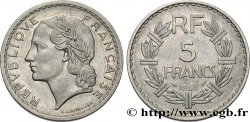v30_1291 - Essai 50 francs Guiraud 1950 Paris F.425/1
MONNAIES 30 (2007)
Startpreis : 200.00 €
Schätzung : 600.00 €
Erzielter Preis : 207.00 €
Anzahl der Gebote : 2
Höchstgebot : 207.00 €
Startpreis : 200.00 €
Schätzung : 600.00 €
Erzielter Preis : 207.00 €
Anzahl der Gebote : 2
Höchstgebot : 207.00 €
Type : Essai 50 francs Guiraud
Datum: 1950
Name der Münzstätte / Stadt : Paris
Prägemenge : 1700
Metall : Bronze-Aluminium
Durchmesser : 27,03 mm
Stempelstellung : 6 h.
Gewicht : 8,11 g.
Rand lisse
Seltenheitsgrad : R1
Kommentare zum Erhaltungszustand:
Superbe exemplaire avec de petites marques de manipulation et quelques petits chocs sur la joue. Quelques légères traces de circulation. Conserve une grande partie de son brillant d’origine
N° im Nachschlagewerk :
Vorderseite
Titulatur der Vorderseite REPUBLIQUE FRANCAISE.
Beschreibung Vorderseite Tête de Marianne aux cheveux longs à gauche, couronnée d'une branche d'olivier portant fruit, ornée d'une cocarde tricolore (centre guilloché horizontalement, cercle ondulé, cercle guilloché verticalement) ; signé G. GUIRAUD derrière, le long du listel.
Rückseite
Titulatur der Rückseite LIBERTE EGALITE FRATERNITE / ESSAI.
Beschreibung Rückseite 1950 / 50 / FRANCS / (millésime encadré des différents) ; coq debout à droite au-dessus d'une branche de laurier vers la gauche.
Kommentare
On doit noter sur cet exemplaire que le coin utilisé était une ruine, choqué de toutes les manières imaginables, qui a transposé ses propres défauts sur la pièce et que la surface du métal présente des striures difficilement compréhensibles. C’est pourtant le nouvel exemplaire de la Collection Idéale, ce qui laisse à penser que toute la fabrication, coins et métal obligent, fut désastreuse.
It should be noted on this example that the die used was a ruin, damaged in every imaginable way, which has transferred its own defects onto the coin and that the surface of the metal presents striations that are difficult to understand. However, this is the new example in the Ideal Collection, which suggests that the entire manufacturing process, including the dies and the metal, was disastrous.
It should be noted on this example that the die used was a ruin, damaged in every imaginable way, which has transferred its own defects onto the coin and that the surface of the metal presents striations that are difficult to understand. However, this is the new example in the Ideal Collection, which suggests that the entire manufacturing process, including the dies and the metal, was disastrous.








 Berichten über einen Fehler
Berichten über einen Fehler Die Seite drucken
Die Seite drucken Teilen meiner Auswahl
Teilen meiner Auswahl Stellen Sie eine Frage
Stellen Sie eine Frage Einlieferung/Verkauf
Einlieferung/Verkauf
 Details
Details










